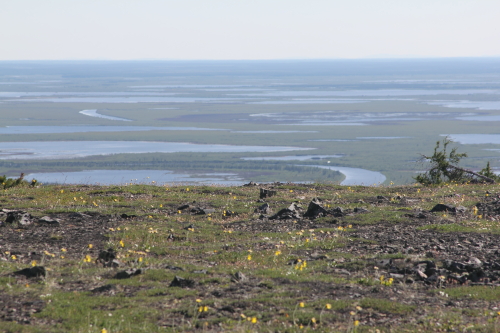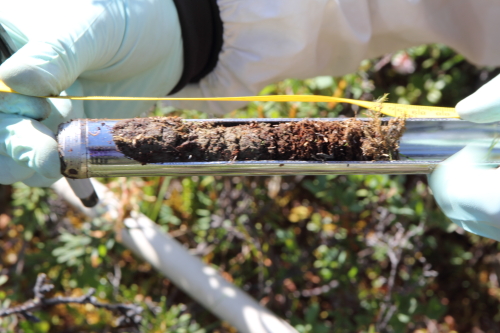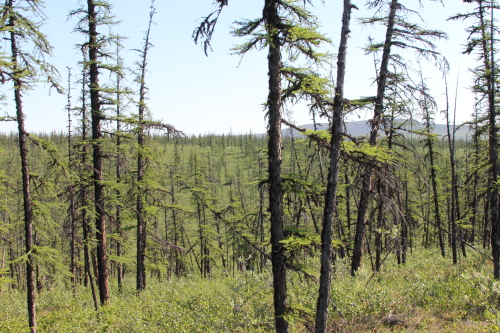I’m trying to imagine it as I look out over this wet, verdant landscape, dark-green stands of larch forest punctuated by lighter green bogs and blue lakes glinting in the bright sunlight: just a couple of meters beneath this visible surface the ground is frozen solid down some 1,400 meters. This is permafrost. It’s typically defined as subsurface earth materials remaining below zero degrees C for two consecutive years. Intending no pun, our PI John Schade said, “Permafrost underlies everything we’re doing here in Siberia.” This is so for two reasons: Permafrost degradation and thawing is probably the most serious natural threat to the stability of our climate resulting from the unnatural warming. And here in northeastern Siberia there is more permafrost by volume than anywhere else in the world. Let’s take the second point first.

A bus ride and a short hike brought us to the top of a small mountain named Rodinka. From there we had an amazing 360 degree view of the surrounding landscape. © Becky Tachihara
The great ice-sheet glaciers that during Pleistocene times subsumed and scoured most of the Arctic and much of northern North America and Europe, spared this region of Siberia. Here over eons, trees, shrubs, and grasses, all manner of local vegetation, lived and died and, with the soil in which they grew, accumulated layer upon layer. Below the surface, insulated from the radiative influence of summer sunlight, these earth materials froze and, undisturbed by the rasping passage of ice, remained permanently present and frozen.
We shouldn’t visualize permafrost simply as uniformly frozen soil and detritus, like that in a peat bog, but as a conglomeration of stuff certainly including organic soil but also silt, dust, minerals, rocks—and great chunks of ice. But if you didn’t know it was down there, you’d never imagine on a hot afternoon that you were walking atop frozen ground. You can’t see permafrost because a film of soil that thaws in summer and refreezes every winter—called the active layer—covers the permanently frozen material. In this region of Siberia, the active layer is one to two meters deep. Its depth determines the nature of the soil, the quantity of water available and, therefore, the nature of the vegetation able to take root. The relatively deep active layer in Siberia allows the boreal forest (covering fully eleven percent of Earth’s land surface) to flourish. In most of the glaciated regions of the Arctic, the active layer is too shallow and/or too dry for trees to grow. Directly beneath the active layer lies an icy “transition zone,” formed during a period of maximum warming in the Late Holocene, separates the active layer from the more stable, nascent, and deeply frozen area below. After this broad, simple description of permafrost in Siberia, let’s look at that second point—the potential threat to our climate, the carbon bomb.

Sam Dunn measures a soil core he will later test in the lab for things such as moisture content and microbial activity. © Becky Tachihara
The authors, including Sergei Zimov, of a September 2008 paper in GeoScience estimate the total soil carbon in the Arctic circumpolar permafrost to be 1,672 petagrams. A single petagram equals one billion metric tons. That breathtaking number is probably an underestimation, the authors say, due to various factors including a scarcity of data. But we needn’t quibble. Give or a take a few hundred billion metric tons, that estimate is more than double the total pool of atmospheric carbon. As average annual temperatures climb in the Arctic, the once-frozen soil will be exposed to the air. What will happen then? The short answer is, no one knows for sure, but it doesn’t bode well for the Arctic or for those of us living to the south.
However, we can say that no arc in nature’s great circular systems is independent of the other pieces of the system. Change inevitably produces feedbacks that reverberate throughout the system. For eons, all those petagrams of carbon have been locked in ice, unavailable to the environment; but here comes the warming and things begin to change in short order, just as a frozen chicken quickly changes when you remove it from the freezer.
It stands to simple reason that in a warming regime the active layer will thicken, deepen. The physical result of this will depend on a couple of factors related to the local topography and the quantity of water produced by the thawing. For instance, if active-layer thawing occurs on a hillside, then the melt water will flow downslope, leaving the organic material high and dry and exposed to the atmosphere—and to the microbes that begin chomping on it. Doing so, they respire carbon dioxide, which is then outgassed into the atmosphere. But what of the melt water that has flowed downslope? It, too, is carrying carbon that has to go somewhere. The carbon-rich material will find its way into the aquatic system, eventually into the Kolyma River and perhaps be borne all the way to the ocean. And en route it will inevitably be consumed by bacteria and other carbon eaters, all respiring fresh carbon dioxide into our atmosphere.

The Arctic often conjures images of snow and ice, but the landscape we are exploring is instead covered with vibrant green, lush vegetation. © Becky Tachihara
In the opposite scenario, if the thawing occurs over a depression in the landscape, then the melt water forms a pond or a lake, and the carbon-rich material, hitherto unavailable in its frozen state, sinks to the bottom. In this oxygen-less state, microbial activity still occurs, but instead of producing carbon dioxide, the microbes produce methane, which as we’ve said elsewhere is twenty-one times more potent a greenhouse gas than carbon dioxide. The methane resides at the bottom of the pond until it produces pressure in the sediment, which in turn generates bubbles, just as boiling water generates bubbles. These then float to the surface and pop in the air, releasing fresh stocks of methane to do its greenhouse work. Ebullition is the fancy term for this bubbling, and we’ll hear more about it later, because it’s responsible for ninety-five percent of the methane emissions from lakes.
Let’s let these two scenarios by which permafrost thawing contributes to increased greenhouse-gas emissions serve for now as an introduction to the subject. It will come up again and again. Later in the month we’ll tow the barge upriver to Duvannyi Yar. There where the Kolyma has eroded high, steep cliffs we’ll be able to see instead of merely imagine a cross section of permafrost and its physical features. But by way of introduction to the problem, we should also mention one other pertinent feedback mechanism—snow—that will likely exacerbate active-layer thawing. Most climate models agree that global warming will generate more moisture in the atmosphere, which will in turn enhance high-latitude snowfall. Snow cover acts to insulate the permafrost from the cold air, thus preventing the active layer from entirely freezing in winter cycle.
“Hand waving” is the scientists’ phrase for alarmist overstatement. No Polaris Project scientist would refer to the global climate threat from permafrost thawing as hand waving. It is no overstatement to say that there are very few mechanisms in nature that are capable—on short timescales—of transferring huge stocks of carbon from the land into the atmosphere. Permafrost thawing heads the short list.
(I owe thanks for their help to PIs Jorien Vonk, Andy Bunn, John Schade, and Paul Mann.)




Comments(3)-
-
Wilhelm Merck says
July 11, 2011 at 5:05 pmDallas – fine writing from an adventurous expedition makes great reading! Some questions from a non-scientist: Do we have enough baseline info to know whether recent warmer air temps are causing novel reactions in these ecosystems? Is there greater hillside subsidence and pooling of meltwater than had been the case previously? (Or do we not need such outward evidence to find C moving about in new ways?) What measures will likely convey the most important info to the average Joe; increased amount of CH4 coming from unfrozen lakes; increased age of melted organic material? So many questions! As the guy who can communicate the science to the rest of us, you have a critical role.
admin says
July 15, 2011 at 10:40 pmMany thanks, Wilhelm, for your note and please pardon my delay in responding–strictly a matter of internet absence.
I wish I could answer your questions as a scientist, but I’m just an interested writer but committed to this kind of outreach. I’m used to doing it aboard WHOI research vessels in the Arctic; this is
my first land expedition, and fascinating it is. Perhaps further essays will address some of you good questions, and I’d be happy to communicate with you back in the States.
The scientists are all concerned about the baseline questions you ask. I’ll pose them to the scientists and get back to you, connection permitting.
For now, thank you and all my best, Dallas